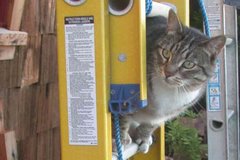Leg 1: Success
The official CASEIS Cruise Blog is located here: http://www.ipgp.fr/caseis This official blog is written by my shift-mate Lola Johannes.
We are refreshed by the blowing wind as we follow it back to port to exchange some crew members (including yours truly), to get some replacement core curation materials, and have one night out on the town before returning to sea for leg 2 of CASEIS.
Leg 1 Comes to an End on 2016/06/20; Leg 2 begins 2016/06/21
June 19, 2016
- We are preparing to core our final cores here on the bridge. From the left are Jean Marie, Dr. Feuillet, Theo (the engineer controlling the ship at the bridge), and Dr. Leclerc. We have an upcoming paper plane competition and Nathalie has two prototypes in her hands. Awards will be based upon overall points, longest flight, best design, and most acrobatics.
- Dr. Christian Beck presented material on sedimentation in a marine setting. He discussed the various inputs, different depositional processes, and the deposits that we have observed in the cores during leg 1 of this cruise.
- What was almost our last piston core for leg 1 returned to the ship in the shape of a pretzel. The core did not penetrate much into the seafloor, so bended to absorb the force of the weight stand.
- Here the 8P-12A shift cuts this core CAS16-28PC. From left to right, Olivia, Artur, and Eva. The sediment at the top and base of the core was 99% organic matter (partially decomposed woody debris. I strongly advocated for a box core at this site. We did not know what was in the PC core (only 1 meter long) and a box core could be used to establish (1) depositional rates here and (2) whether recent seismicity was recorded at this location.
- Here Artur and Eva clean and label this core.
- Dr. Feuillet and the captain discuss her stereo microscopic observations of the organic woody debris.
- The location of this and the box core CAS16-29BC are at the middle of the red line in the map below. Color represents depth and the color scale on the right shows red = shallow and blue = deep. The blue areas are in the trench. The green/orange areas are (1) on the left, the accretionary prism and (2) on the right, the Barracuda ridge (associated to a fracture zone and likely controls segmentation of the subduction zone).
- Here is a view of the seafloor surface as collected in the box core CAS16-29PC. The surface is an oxidized red-brown clay.
- Here Marie and Dr. Ratzov watch Dr. Beck insert one of the sub-sampling cores into the box core. We drilled holes into the pipe and are using a threaded rod as a handle to insert the pipe.
- This is an exposure of 29BC. Quentin D. is pleased that this core contains interesting stratigraphy. The base is a grey-green clay. As we remove sediment so that we can collect the sub-sample cores, we learn more about the stratigraphy.
- This is a close up view of the core after we removed some sediment. This is a great way to see the stratigraphy. There are reddish brown layers and these layers appear to have a high organic content. The CT data from these cores will be very interesting. We do not see any turbidites here, but muddy turbidites are difficult to see with the naked eye. There are some parts of the stratigraphy that appear to not be laminated like the reddish brown layers.
- We moved the ship to a nearby location to take another piston core. Here the engineers change the core position from horizontal to vertical.
- Here Theo and Martin discuss the ship’s operations as we conduct seismic surveys for the remaining of leg 1.
- Here is a compilation map showing the location of all our cores locations cored on leg 1 of CASEIS.


















No comments:
Post a Comment